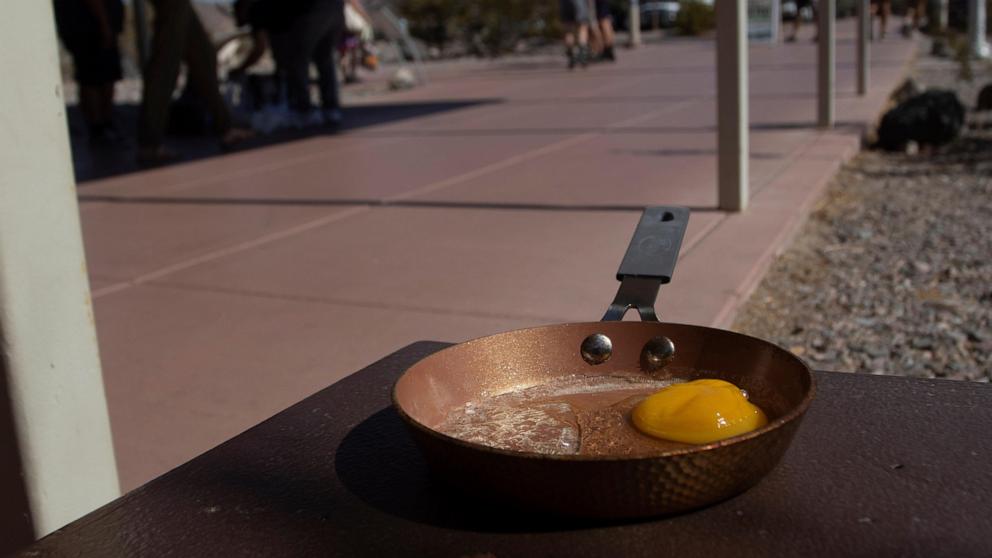Despite the scorching heat wave in the USA, tourists are still flocking to Death Valley. Several people die there

DEATH VALLEY, Calif. — Hundreds of Europeans traveling the American West and adventurers from across the U.S. nevertheless flocked to Death Valley National Park on Monday, even as the desolate region, considered one of the hottest places on Earth, is being hit by a dangerous heat wave blamed for the death of a motorcyclist over the weekend.
French, Spanish, English and Swiss tourists left their air-conditioned rental cars and RVs to snap photos of the barren landscape, so different from the snow-capped mountains and rolling green hills they know from home. American adventurers liked the novelty, even as park officials in California warned visitors to be cautious.
“I was excited that it was going to be so hot,” said Drew Belt, a resident of Tupelo, Mississippi, who planned to stop in Death Valley, the lowest-elevation spot in the U.S., on his way to climb California’s Mount Whitney, the highest peak in the lower 48 states. “This is a once-in-a-lifetime opportunity. Kind of like walking on Mars.”
Park ranger Mike Reynolds warned visitors in a statement that “such intense heat can pose a real threat to your health.”
The scorching heat wave that has swept across much of the United States also brought record-breaking temperatures in Oregon, where it is believed to have caused four deaths in the Portland area. More than 146 million people in the United States, mostly in the western states, were under heat warnings on Monday.
Previous heat records were reached or broken in numerous locations across the West and Pacific Northwest over the weekend, and those numbers are expected to continue into the coming week.
The early heat wave in the U.S. came as global temperatures hit a record high for the 13th consecutive month in June and the 12th month in a row that the Earth was 1.5 degrees Celsius (2.7 degrees Fahrenheit) warmer than pre-industrial times, Europe’s Copernicus climate service said.
In Oregon’s Multnomah County, home to Portland, the medical examiner’s office is investigating four suspected heat-related deaths recorded Friday, Saturday and Sunday, officials said. Three of the deaths involved county residents ages 64, 75 and 84, county officials said in an email. Heat was also suspected in the death of a 33-year-old man who was admitted to a Portland hospital from outside the county.
Portland broke daily record temperatures on Friday, Saturday and Sunday and will do so again on Monday with a forecast high of 102 F (38.9 C), National Weather Service meteorologist Hannah Chandler-Cooley said. High temperatures are expected in Portland through Tuesday evening.
Temperatures are not expected to be as high as a similar heatwave in the Pacific Northwest in 2021, which killed an estimated 600 people in Oregon, Washington and Western Canada. However, the duration of the heatwave could be problematic because many homes in the region do not have air conditioning.
Heat illnesses and injuries are cumulative and can build up over the course of one or more days, officials warn. In San Jose, California, a homeless man died last week from apparent heat-related causes, Mayor Matt Mahan reported on the social platform X, calling it “a preventable tragedy.”
In the scorching desert of Eastern California, high temperatures of 53.3 degrees Celsius were recorded in Death Valley National Park on Saturday and Sunday. One visitor, whose identity is unknown, died of the heat on Saturday. Another person was hospitalized, authorities said.
They were among six motorcyclists who rode through the Badwater Basin area in sweltering heat, the park said in a statement. The other four were treated at the scene. Rescue helicopters were unable to respond because the aircraft generally cannot fly safely in temperatures above 120 degrees Fahrenheit (48.8 degrees Celsius), officials said.
Even more extreme temperatures are expected in the near future, with a high of possibly 54.4 °C (130 °F) around midweek.
Death Valley, the largest national park outside of Alaska, is considered one of the most extreme environments in the world. The highest temperature ever officially recorded on Earth was 133.6 °F (56.67 °C) in July 1913 in Death Valley, although some experts dispute this measurement and say the true record is 132.6 °F (54.4 °C) recorded in July 2021.
“It’s impressive,” said Thomas Mrzliek of Basel, Switzerland, of the triple-digit heat. “It’s like a wave hitting you when you get out of the car, but it’s a very dry heat. So it’s not like Europe.”
Across the desert in Nevada, Las Vegas recorded a record high of 120 F (48.8 C) on Sunday and was forecast on Monday to reach a record high of 46.1 °C (115 °F). The National Weather Service forecast a high of 47.2 °C (117 °F) for Phoenix.
Extreme heat and a prolonged drought in the West have also dried out vegetation that can fuel wildfires.
In California, a forest fire in the mountains of Santa Barbara County had spread to more than 88 square kilometers by Monday evening. More than 1,000 firefighters were deployed, and the areas subject to evacuation orders included the former Neverland Ranch, once owned by the late pop star Michael Jackson. The fire was only 8 percent contained.
Rare heat warnings were even extended to higher elevations, including around the normally temperate Lake Tahoe on the California-Nevada border. The weather service in Reno, Nevada, warned of “high heat risks, even in the mountains.” For the third day in a row, the city of South Lake Tahoe, California, reached a high of 32.7 °C (91 °F), surpassing the previous record of 31.6 °C (89 °F) set in 2017.
And for the first time since weather records began in 1888, Reno reached 40.5 °C (105 °F) for the third day in a row. Shortly afterwards, on Monday, the city reached a new record of 41.1 °C (106 °F), surpassing the previous record of 40 °C (104 °F) set in 2017.
On Monday, people flocked to the beaches around Lake Tahoe, especially Sand Harbor State Park, where a new record of 93.3 degrees Fahrenheit was set on Sunday, beating the old record of 88.1 degrees Fahrenheit set in 2014. For the fifth day in a row, Sand Harbor closed its gates within 90 minutes of opening at 8 a.m. because it was at capacity.
“It’s definitely hotter than we’re used to,” said Tyler Kerver, spokesman for Nevada State Parks.
___
Rush reported from Portland, Ore., and Snow from Phoenix. AP journalists Christopher Weber and John Antczak in Los Angeles, Janie Har in San Francisco and Scott Sonner in Reno, Nevada, contributed to this report.



